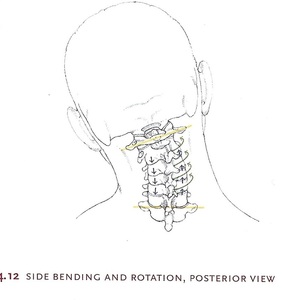|
The more I practiced yoga, the more I find areas of my body that have been neglected. Three previous car accidents have left my cervical spine (neck) in a bit of disarray. My focus has been on my hip and back for years and the neck just didn't get the well-deserved attention that it needed. Lately, I've been working on limbering up my neck as the pain and tightness has increased. More formal treatment through chiropractic and physical therapy have been my main forms of repair; however, I've started to be watchful of my neck during my yoga practice and day to day activities. Much similar to my focus to stand straight! This past week I borrowed the book, Yogabody: Anatomy, Kinesiology, and Asana by Judith Hanson Lasater, from the library and the first chapter I jumped into was the neck. I found two very interesting things in the chapter. The first being how the cervical spine rotates and the second being a safety precaution that is a "need to know" for an aspiring yoga teacher. Here are the details. 1. The General Rule of Side Bending and Rotation of the Cervical Spine The Hanson Lasate writes: "In the cervical region, side bending and rotation occur to the same side, regardless of the position of the cervical spine at the beginning of the movement. For example, when you side bend to the left, the bodies of the vertebrae also rotate to the left. In other words, as the bodies rotate right, the spinous processes [rear portion of the vertebrae] are pointing left." Photo Credit: Yogabody: Anatomy, Kinesiology and Asana I contemplated this idea for some time by palpating my spine and bending and rotating. The really great thing about this book is that each chapter ends with suggested asanas to try. This chapter ended with triangle pose (Utthita Trikonasana) which was interesting to explore. As the body rotates to the right in triangle pose, the natural tendency is to have the cervical spine body rotate to the right as well. Yet, in this pose the face is cued to look upwards and thus, the cervical spine is rotating in the opposite direction. Hanson Lasate writes: "We can override this law by purposely choosing another action. But it is likely that when we do, there may be discomfort." That's why my neck feels so awkward in triangle pose. Interesting! Next time in triangle pose, I'll listen to my body and look forward or down once the neck starts to ache. 2. Caution: Protect the Vertebral Artery As I was reading the chapter, I came across a crucial safety precaution when moving the cervical spine in asanas. Hanson Lasate writes: "The movement of the cervical spine can directly affect the blood supply to the brain. This artery [the vertebral artery] can be occluded [blocked] by a combination of rotation and extension...if you rotate to the right and backbend to the right you can occlude the right vertebral artery." This makes total sene when yoga teachers are cueing a seated spinal twist. They always say keep the chin parallel to the floor because if I extended my neck backward, I would block off my main artery to my brain. A key thing for me to know when I begin to teach!
So, the neck, as many other areas of life, needs some attention. And it will be getting the care to reduce its irritation in the upcoming days and practice. LW
0 Comments
Leave a Reply. |
Aspiring Yoga TeacherI've practiced yoga since I was a pre-teen and have always found it to keep me centered. I will be a teacher one day and this is my journey to discover teaching and practice. Archives
April 2019
Categories
All
|
Edmonton, Alberta

 RSS Feed
RSS Feed